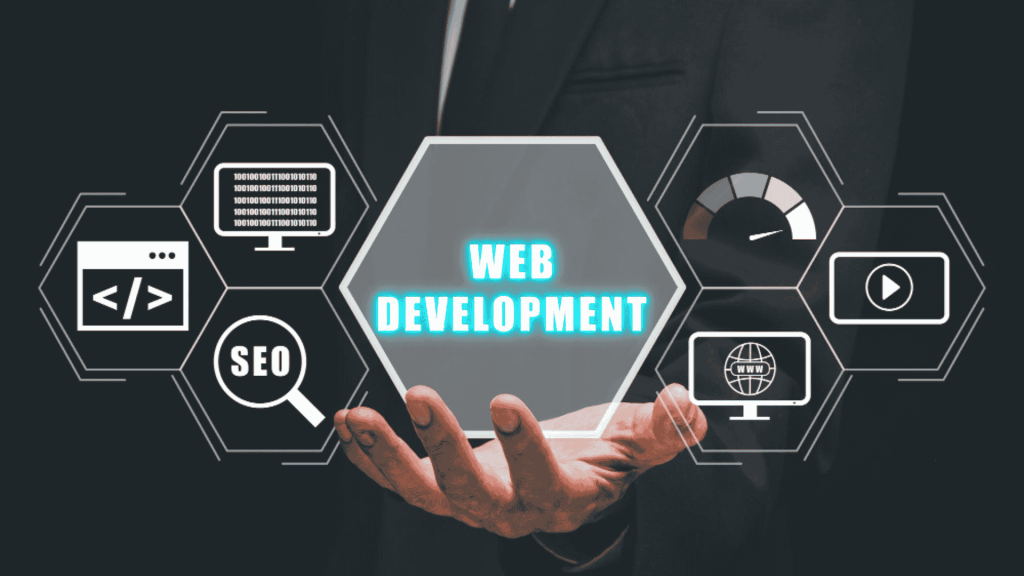The web development trends 2025 are evolving rapidly. As the need for web application development services continues to rise, it is essential to keep up to date with the latest trends in web development.
Web development frameworks, such as React Remix and Next.js, are emerging and creating a significant impact. They might signal the future of web development in 2025.
Market data indicates that the global web development market will reach $130.9 billion by 2032. Technologies like AI, blockchain, and voice search are fundamentally changing the web space, so web development technology trends will continuously transform the digital world.
Below are the top 10 trending web development trends 2025. These growth trends in web development will assist you in future-proofing your business and putting it in a class of its own when designing a digital experience.
Top 10 Web Development Trends 2025
1. Cybersecurity in Web Development
Cybersecurity is a significant consideration in web development technology trends, especially given the increase in cyberattacks. With defensive measures against protecting sensitive data and maintaining user confidence through key practices.
Key Practices:
Multi-Factor Authentication (MFA): Multi-Factor Authentication (MFA) increases security and protection from unauthorized access by recognizing multiple verification techniques.
Regular Security Audits: Regular security audits increase compliance with security measures and identify any vulnerabilities.
Secure Coding Practices (SCPs): Correct coding practices prevent common threats such as SQL injection, Cross-Site Scripting (XSS), and other vulnerabilities.
Overall, website development has dramatically increased the demand for automated AI agents for IT security. There are also positive elements of cybersecurity in website development, like strong encryption and security protections against unauthorized access and data breaches regarding data.
2. Dark Mode in Web Technology Trends
In 2025, dark special mode moved from being a design gimmick to becoming an actual user preference. As it becomes a standard feature of modern web design for its aesthetic and practical utilities, technically, it’s a stylistic, minimalist, visually concise aesthetic that gives dark mode more tools with accessibility and usability in the dark!
Developers apply dark mode feature functionalities using CSS and JavaScript toggles, empowering users’ visual experience.
There are benefits to dark mode:
- Reduced eye strain: It diminishes glare and curbs blue light exposure, allowing for easier browsing during nighttime hours.
- Maximizing battery: This applies mainly to devices with OLED or AMOLED screens, maximizing battery life.
- Modern aesthetic: Matches current UI/UX design trends and user propagation expectations.
A study by Android Authority revealed that 91.8% of users prefer dark mode when available, indicating its significance in web technology trends.
3. User Research and Personalization
User research is an important part of creating unique web experiences tailored to personal preferences, which can make for a more engaging and enjoyable encounter. Developers can create applications that meet specific needs, engage user behavior, and enhance performance and usability.
Strategies:
- A/B Testing: Evaluate different iterations of a page or experience to determine which resonates best with users.
- User Surveys and Feedback: Users can provide qualitative data that gives insight into their expectations and pain points.
- Analytics Tools: These tools will let you track user interactions, allowing designers to correct course based on the data to increase user engagement.
Based on exhaustive user research, personalization will remain a driving force in web development in 2025. It promotes engagement, increases satisfaction, and improves the overall user experience.

4. Progressive Web Apps
Progressive Web Apps (PWAs) are paving the way for future web development in 2025 by combining the best features of mobile and web applications. They provide fast, reliable, and engaging experiences via a user’s web browser with no app store downloads. PWAs are especially beneficial for businesses looking to increase accessibility and user retention.
Advantages:
- Offline Capability: Users can stay connected to content anytime without an internet connection.
- App-like Capabilities: Navigating with smooth animations, push notifications, and responsive design, them being in a browser.
- Simple Install Process: One tap from the homepage to the user’s home screen without the app store.
Major brands such as Starbucks and Pinterest are reporting massive gains in performance and user engagement after implementing PWAs, validating that they are a critical part of technology trends applicable to web development for 2025.
5. Optimized Voice Search
With voice assistants like Siri, Alexa, and Google Assistant continuing to change our lives, voice search optimization is an essential topic for web development industry trends 2025. Users now speak instead of typing, and developers must adapt websites to make them natural, conversational, and easy to search.
The move to voice search goes hand-in-hand with our growing need for hands-free, fast, user-friendly browsing experiences. A few implementation tips are:
- Conversational Keywords: Use long-tail keywords that approach real speaking habits and rhythms.
- Structured Data: Embed schema markup to allow search engines to understand your content more easily.
- Mobile optimization: Think fast-load, responsive initiatives for voice-initiated traffic.
Statista forecasts that the global voice recognition market will be $27.16 billion by 2026, so its growing importance cannot be overstated.
6. AI-Powered Chatbots
AI-based chatbots in customer service offer a new way to provide immediate and continuous support. That’s why they stand out among the current trends in web development. These smart systems use machine learning and deliver personalized, efficient interactions that improve the user experience.
Benefits:
- 24/7 Availability: Provides continuous support so clients’ needs are always met.
- Cost Savings: Freedom from extensive support and customer service teams, saving businesses money.
- Personalized Experiences: Uses user data to generate thoughtful, contextualized responses.
Drift’s analysis indicates that 41% of marketers feel that AI has significantly enhanced the customer experience. This shows the necessity of using AI in current web development and its capacity for proactive growth and increased customer engagement, and satisfaction.
7. Accelerated Mobile Pages
Accelerated Mobile Pages (AMP) are a fantastic option for constantly changing web development trends. AMP aims to improve browsing on mobile devices through fast page load times, with speeds increasing at a higher rate than standard HTML.
AMP uses a slightly altered version of HTML that prepares pages for swift content delivery. This helps keep users on your page as long as possible, decreases bounce rates, and is even more critical in a mobile-first approach to websites.
Key Features:
- Reduced Load Times: Pages take less than 2 seconds to load, creating a better user experience and retention.
- SEO Advantages: AMP pages typically catch mobile traffic first, providing better visibility.
- Streamlined Content: Presents core message without excess bloat, ideal for the mobile consumer on the go.
Incorporating AMP into your website follows the trending web development technologies to enhance mobile accessibility.
8. Single Page Application
SPAs, or single-page applications, have emerged as a cornerstone of modern web development. They provide a compelling interactive experience and dynamic user interactions. SPAs load their content dynamically, constantly updating the webpage without reloading it.
Advantages:
- More Efficient Performance: SPAs lessen the server load by eliminating page reloads, meaning the server can respond faster to requests.
- Better Experience: SPAs are more like apps than web pages because they eliminate page refreshes to improve navigation. It allows for easier interactions and keeps the user focused on the experience, which can increase engagement.
- Easier to Develop: SPAs can take advantage of being focused on one HTML page, so there are fewer bugs to track, easier tests, and easier code maintenance.
SPAs can benefit any app, but they work especially well when users expect frequent updates (e.g., a social media app or e-commerce site). They are at the forefront of web technology trends and are an important part of user-focused technology.
9. Motion UI
Motion UI has become an important aspect of usability in creating attractive and interactive web experiences. It is one of the newest front-end development trends for 2025, adorned with visuals and engaging users through transitions, animations, and a narrative driven by visuals to elevate overall usability.
Benefits:
- Visual Feedback: Helps users understand actions through smooth animations.
- Brand Identity: Strengthens recognition with distinct motion elements.
- User Engagement: Attracts attention and increases time spent on a site.
- Better UX: An intuitive interface leads to an improved navigation experience and flow.
Apple does a great job creating slick, subtle scrolling animations, allowing a seamless and engaging experience. Motion UI is more than just flair; it’s about creating fluid, functional user experiences that keep visitors interested and returning for more.
10. Blockchain Technology in Web Development
Blockchain is quickly becoming a disruptive innovation in web development beyond the original purpose of cryptocurrency. Its advantages in terms of transparency, improved security, and decentralization are critical in modern web applications involving sensitive data and transactions.
| Feature | Benefit |
| Decentralized Apps | Eliminates the need for central servers |
| Data Integrity | Secure and tamper-proof |
| User Verification | Reliable identity management |
Common Use Cases:
- Secure Online Payments: Enables encrypted, traceable, and fast transactions.
- Smart Contracts: Payment contracts are executed automatically without needing a third party.
- Decentralized Identity Verification: Decrease fraud and protect user privacy.
Implementing blockchain technology allows developers and other browser-based systems to create more trustworthy, transparent, and durable systems, following the progressive web technology standards in 2025.
Bonus: Additional Trends Shaping Web Development in 2025

While the previous trends highlight the core of future web development, several emerging technologies are also making a substantial impact. These “bonus” trends may not always make the top 10 lists, but they’re rapidly becoming essential for creating fast, scalable, and innovative web experiences.
a. Cloud Integration
Cloud services have emerged as a pillar of web development today. They offer scalable and flexible infrastructure, allowing developers to build and run applications without considering physical servers.
Some popular cloud services include AWS, Google Cloud, and Microsoft Azure. Additionally, there are cloud services that enable serverless and real-time data processing.
b. WebAssembly (Wasm)
WebAssembly is changing the landscape concerning performance. WebAssembly allows languages such as C, Rust, and Go to run in the browser. WebAssembly offers near-native speed for most web applications, enabling computation-heavy functionality (e.g., gaming, video editing, simulations) to run directly in the browser.
c. Low-Code & No-Code Platforms
These platforms are a game changer for organizations, particularly startups and non-technical teams, to build and launch websites and applications rapidly. These tools, Bubble, Webflow, and OutSystems, minimize the reliance on code and can accelerate development time.
d. Edge Computing
Edge computing processes data closer to the user than a central server. The result is significantly reduced latency, improved load times, and ultimately better real-time experiences for users, especially for far reaches of the globe.
Tips for Staying Ahead of the Curve
Learning new tools is not enough to stay ahead of the rapidly changing web development landscape. It involves thinking and acting proactively and reactively. To remain relevant and competitive in 2025 and beyond, businesses and developers alike should consider the following:
- Stay Informed: Follow some of the top developer blogs, subscribe to their newsletters, watch their YouTube tutorials, and attend technology conferences like Google I/O, Apple WWDC, Web Summit, and JSConf to keep in touch with the latest tools and best practices.
- Experiment Early: Do not wait to experiment with new frameworks, libraries, and APIs until they are mainstream.
- Change is Good: Move away from systems over the hill and use scalable ones. This transition often leads to better performance and security.
- Learn Continuously: The tech industry is fast-paced. Habitually, continuously learn via online courses, webinars, and applied projects. What is popular today may be obsolete tomorrow.
By following the tips above, you will ensure that your skillset remains usable and innovative in what you do!
The Impact of Trends on Website Performance
Let’s take a moment to understand how adopting these trends can boost performance and user satisfaction:
| Trend | Performance Impact |
| AMP | Faster mobile load time, better SEO |
| PWAs | Seamless experience, offline access |
| AI Chatbots | Reduced bounce rate, better engagement |
| Voice Search | Improved search ranking, accessibility |
| Motion UI | Enhanced UX, brand trust |
| Blockchain | Increased security and transparency |
Wrapping Up
Web development is no longer just about building functional websites. It’s about creating fast, secure, interactive, and future-ready digital experiences. Whether you’re a startup owner, an enterprise developer, or a solo freelancer, staying ahead of the latest web development trends for 2025 is non-negotiable.
But doing so will be time well spent, as it will help you protect your company, increase sales, and improve customer satisfaction. Some additional perks of building a website for your business are increased visibility and accessibility, brand recognition, higher customer loyalty, and much more. Stay on top of your game!
Integrated IT Solutions can help you achieve endless business growth opportunities using the latest web development potential. Contact us today!
FAQs
1. Why is cybersecurity a trend in web development 2025?
Because cyberattacks are rising, developers must prioritize security to protect user data and build trust.
2. What is the future of web development beyond 2025?
The future lies in automation, AI integration, immersive UX (via AR/VR), and ultra-fast, secure platforms with real-time capabilities.
3. Are Progressive Web Apps replacing mobile apps?
Not entirely, but PWAs are an intense alternative offering app-like experiences without downloads.
4. How do I implement dark mode on my website?
CSS media queries like @media (prefers-color-scheme: dark) can help you design for dark mode.
5. Do I need to learn Blockchain as a web developer?
It’s not mandatory, but understanding the basics can open doors to decentralized applications and secure web services.





